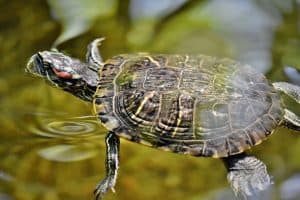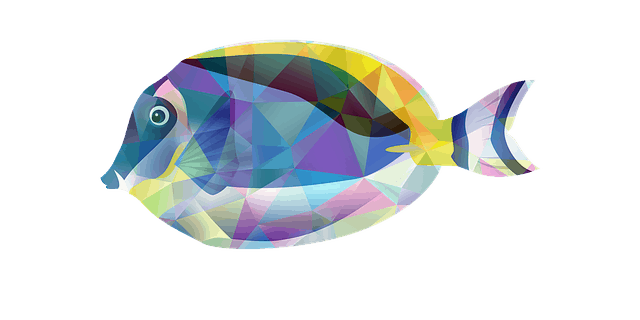Perhaps you’ve recently purchased an aquarium and are now wondering what to put in it! Well, apart from the obvious choice, which (of course) is fish, there are other animal species you could consider like frogs, lizards and aquatic turtles. Right now, you may be wondering to yourself, ‘is it possible to keep a turtle in a 10-gallon tank?’
No turtle species would be able to live in a 10-gallon tank for life. The minimum size an aquarium should be to house a turtle is a 40-gallon breeder tank and even that would only work temporarily for a hatchling or perhaps a smaller species, such as a mud or musk turtle. As far as pet turtles are concerned – the bigger, the better when it comes to aquariums!
Now that you know a 10-gallon tank isn’t big enough for a turtle, let’s explore this concept in more detail below. We’ll discuss why a 10-gallon tank isn’t good for turtles and what tank size is best. We’ll also explain how to setup a temporary 10-gallon turtle tank as well as explore other animal species that can live in a small aquarium.
And so, if you’re ready to learn more about turtles and tank sizes, then let’s get to it!
Is a 10-Gallon tank Big Enough for a Turtle?
Unfortunately, a 10-gallon tank is simply not big enough for a turtle. In fact, a 40-gallon tank is the smallest an aquarium could be for any turtle, even a hatchling or a small species like the mud turtle. A mud turtle is a tiny aquatic species that rarely grows bigger than 5 inches. In fact, even this minute of a creature needs a surprisingly large aquarium to thrive – a 75-gallon tank is recommended!
How Do You Setup a 10-Gallon Turtle Tank?
If you want to raise turtles, you’ll need a large aquarium. However, if you have a 10-gallon tank, you can use it temporarily (up to a year) to rear a turtle hatchling. Once the turtle reaches 4 or 5 inches in length, it should be moved to a bigger tank – at least a 40-gallon size or greater!
To setup a temporary tank for turtle hatchlings, you’ll need to follow these 10 steps:
- Begin by spreading substrate on the bottom of the tank. choose a fine substance like sand, gravel or fluorite.
- Create a ‘land area’ that takes up 50% of the tank space. Avoid using logs or rocks from outside as they pose a health risk. Instead, buy a floating turtle dock from a pet supply store.
- Add a few decorations, such artificial plants. Do not use enclosure-type decorations as your turtle could accidently get stuck in them!
- Fill-up the tank with clean water, making sure the depth is at least ¾ of the length of the turtle. You can use either tap or distilled water as most pet turtles are freshwater creatures.
- Hook a lamp with both UVA and UVB bulbs to the side of the tank where the ‘land area’ is. Leave the light for 12 hours each day followed by 12 hours of darkness.
- Add a fully submersible water heater to the tank to keep the temperature consistent year-round. The ideal temperature will depend upon the species of turtle you have.
- Invest in a large canister filter, as turtles produce more waste than fish, on average. Even with a filter, you’ll still need to change the water at least once every two weeks.
- Select a tank cover that’s heat resistant with a metal screen. This will help protect your turtle from the potential danger of a broken lamp bulb. Avoid using a glass or plexiglass cover as they could shatter or melt.
- Buy a thermostat and use it to monitor the water and land areas regularly. Most turtle species prefer a water temperature of about 78 degrees Fahrenheit (or 25 degrees Celsius) and land temperature somewhere between 80 to 85 degrees Fahrenheit (or 27 to 29 degrees Celsius).
- Consider getting a hygrometer to help test the relative humidity in the tank occasionally. The appropriate moisture level will depend on the type of turtle you have. This tool is optional, but I recommend it.

What Size Tank Do You Need for a Turtle?
The size of the tank needed to raise a turtle depends upon its size. A 40-gallon aquarium is okay for a smaller species, between 4 and 6 inches long. Turtles that are 6 to 8 inches long need a bigger tank, at least a 55-gallon size. Turtles that are longer than 8 inches require an even larger tank, somewhere in the 75- to 125-gallon range!
For your turtle to be happy and healthy, you must ensure that its habitat is big enough. The ‘rule of thumb’ when it comes to choosing a tank is at least 10 gallons of water for every turtle inch. Plus, an additional 5 gallons for each additional turtle inch. Bigger is always better when it comes to raising turtles in captivity so when in doubt, opt for the largest possible aquarium!
Can You Keep a Turtle in a 30-Gallon Tank?
A 30-gallon tank would be the absolute minimum size for a tiny turtle – that being a hatchling or small species such as the mud turtle, which only gets to be about 5 inches long! In fact, I wouldn’t recommend anything less than a 40-gallon tank. A 55-gallon aquarium is a better choice. The bigger the tank, the better for your turtle. And, if you plan to raise more than one, consider using at least a 75-gallon tank.
What Animals Can Live in a 10-Gallon Tank?
If you don’t plan to upgrade to a larger tank in the future, then you should probably consider getting other creatures (besides turtles) for your 10-gallon tank. There are so many options available, from fish to frogs, snakes to lizards. A naturally thriving, unique aquatic or terrestrial ecosystem is indeed possible with even a small aquarium. Let’s explore some of them may possibilities below.
Fish
Fish are the ideal creatures for an aquarium. Both freshwater and saltwater species can live in a 10-gallon tank, provided they’re small. A few examples to choose from include:
- Betta fish
- Butterfly fish
- Cory Catfish
- Dwarf Gourami fish
- Goby fish
- Guppy fish
- Platy fish
- Tetra fish
Frogs
Exotic creatures, including frogs can also be raised in a 10-gallon tank. Some species to consider include:
- African Dwarf frog
- African Green Tree frog
- Fire Belly frog
Invertebrates
Aquatic invertebrates are also a great addition to a 10-gallon tank. The best ones to consider include:
- Clams
- Snails
- Hermit crabs
- Ghost shrimp
- Peppermint shrimp
- Millipedes
- Scorpions
- Tarantulas
Lizards
Lizards are also suitable for most 10-gallon tanks, provided they’re small. A few to think about include:
- Leopard geckos
- Flying geckos
- Golden geckos
- Panther geckos
- Pygmy chameleons
Shrimp
Freshwater shrimp are also ideal for a small aquarium. In fact, you can put as many as 100 in a 10-gallon shrimp-only tank! Some species to consider include:
- Blue Tiger shrimp
- Crystal Red shrimp
- Ghost shrimp
- Panda shrimp
- Peppermint shrimp
Snakes
Smaller snakes can be kept in a 10-gallon tank as well. However, if they grow larger than expected, you may have a problem! A few species to contemplate include:
- Egg-Eating snakes
- Garter snakes
- Rosy Boa snakes
These are just a few of the many possible species you could consider for a 10-gallon tank. Be sure to do your research in advance, however. Not all aquatic creatures can live in the same environment. Some like the Harlequin shrimp, Tube Anemone fish and Cherry Picked zoanthid (coral), for example, must be part of a ‘species-only’ tank.
Conclusion
In summation, there is no turtle species that could live its entire life a 10-gallon tank. The smallest possible aquarium for a turtle is a 40-gallon tank and that would only really work for a hatchling or perhaps a smaller species, like a mud or musk turtle. When it comes to turtles and aquariums, bigger is always better!
Hopefully this article has been of help to you. Thanks for reading and good luck with your aquarium!
Related Aquariums at Homes Articles
What is a 40gallon Breeder Tank?
Can Koi fish Live in a Fish Tank?






